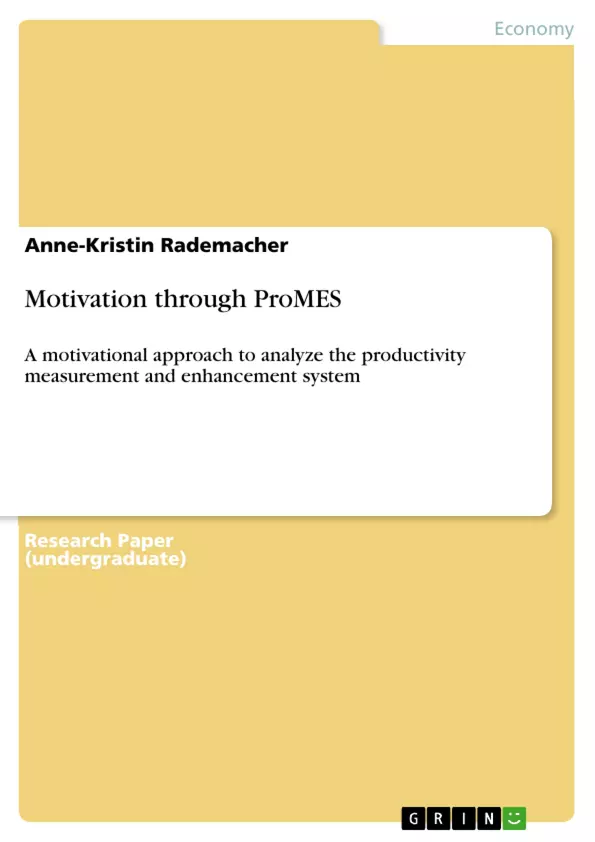It is in the nature of humans to increase own welfare. Profit orientation of shareholders and demands of employees are reflected by the same target: prosperity. Successful companies yield profit for shareholders, but also secured working places, good salary and wage developments, even shareholding is possible (cf. Kleinbeck et all 2001, p. 24). In order to be successful productivity continuously has to be improved. Increasing productivity means to accomplish more with less. This movement is driven by the concept of scarce resources as well as the growing competition on the markets, enabled by globalization.
The productivity of a company strongly depends on the input of employees. Until the 60s it was assumed that employees are firstly motivated by economic incentives and only later through security of employment and fair working conditions. With the human relation movement abandoning wage incentives it appeared that there should be more factors that influence the productivity of employees. It was assumed that employee satisfaction and intrinsic motivation lead to success (cf. Spender 1961, p. 426).
The core question is: how are employee satisfaction and motivation developed and how can they be used to drive productivity? The productivity measurement and enhancement system from Pritchard shall give a response to this question. Pritchard states, “the idea is to give people the tools to do the work better while at the same time help them feel a sense of ownership in the resulting system and empowerment in determining important aspects of their work” (cf. Pritchard 2011). Lean manufacturing concepts, such as world class manufacturing, are built upon this idea.
The paper on hand raises the question if employees are being motivated by the productivity measurement and enhancement system? In order to answer this question the concept of motivation will be closer defined. In a second step, a solid knowledge foundation on the productivity measurement and enhancement system is needed. Literature on the Pritchards system concentrates on the outcome productivity rather than motivation itsself. Therefore a theoretical analysis is made upon the system by means of application of motivational theories. Under the assumption that productivity is a result of motivation the question will also be answered through gained experience from implementation in business. In conclusion motivation increasing and decreasing aspects will give weight on answering the question.
Inhaltsverzeichnis (Table of Contents)
- Introducing the topic
- From work to motivation and ProMES
- The term motivation
- The management system ProMES
- The idea of ProMES
- The development and implementation in organization
- Finding motivational aspects in ProMES
- Pritchard motivational approach NPI
- The key elements in ProMES
- Group work
- Participation
- Goal setting and Feedback
- Weighting motivational aspects in ProMES
Zielsetzung und Themenschwerpunkte (Objectives and Key Themes)
This paper investigates whether the ProMES (Productivity Measurement and Enhancement System) effectively motivates employees. It aims to establish a solid understanding of both the concept of motivation and the intricacies of the ProMES system, with particular focus on its motivational aspects. The paper will examine the application of motivation theories to ProMES and analyze its impact on employee productivity.
- Motivation in the workplace and its relation to productivity
- The ProMES system: its development and implementation
- Motivational aspects of ProMES, including group work, participation, and goal setting
- Impact of ProMES on employee productivity and its potential for increasing motivation
- Analysis of the relationship between motivation and productivity within the ProMES framework
Zusammenfassung der Kapitel (Chapter Summaries)
- Introducing the topic: This chapter introduces the topic of employee motivation and its relationship to productivity. It examines how companies can achieve success through improved productivity, emphasizing the role of employee input in this process. The chapter highlights the shift in thinking regarding employee motivation, from purely economic incentives to a broader focus on satisfaction and intrinsic motivation. It introduces the ProMES system as a potential solution to enhancing productivity by leveraging employee motivation.
- From work to motivation and ProMES: This chapter defines the term "motivation" and provides an in-depth overview of the ProMES system. It explains the concept behind ProMES, outlining its development and implementation process. The chapter emphasizes the importance of giving employees tools to improve their work while fostering a sense of ownership and empowerment in their roles.
- Finding motivational aspects in ProMES: This chapter delves into the motivational aspects of ProMES. It introduces Pritchard's motivational approach, known as NPI, and analyzes the key elements of ProMES, such as group work, participation, and goal setting. This chapter explores how these elements contribute to employee motivation and productivity.
- Weighting motivational aspects in ProMES: This chapter examines the influence of different motivational aspects within ProMES. It analyzes how elements like group work, participation, and goal setting contribute to both increasing and decreasing motivation. This chapter assesses the overall effectiveness of ProMES in motivating employees.
Schlüsselwörter (Keywords)
This paper focuses on key concepts like employee motivation, productivity enhancement, ProMES, motivational theories, employee satisfaction, and the relationship between motivation and productivity. The research examines the implementation of the ProMES system, drawing from existing literature and incorporating motivational approaches like Pritchard's NPI model.
- Citation du texte
- Anne-Kristin Rademacher (Auteur), 2012, Motivation through ProMES, Munich, GRIN Verlag, https://www.grin.com/document/201567



